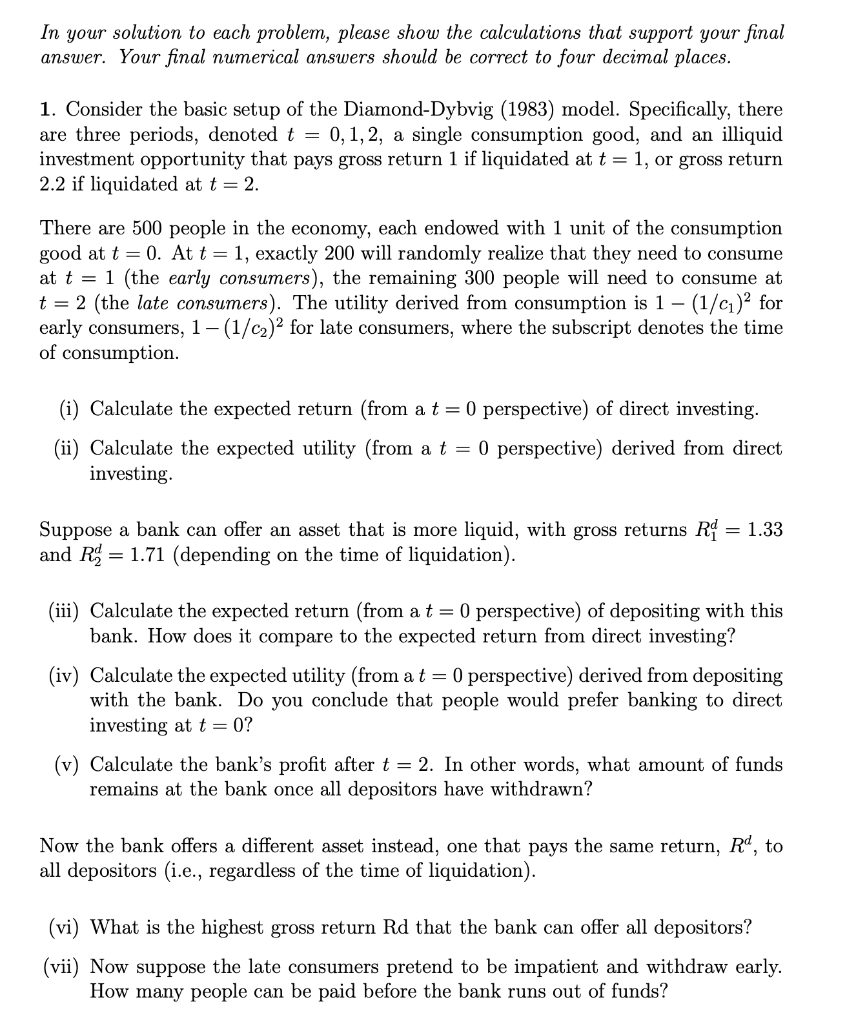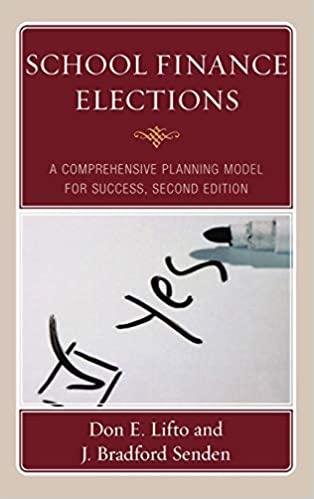CAN IGNORE FIRST TWO
In your solution to each problem, please show the calculations that support your final answer. Your final numerical answers should be correct to four decimal places. 1. Consider the basic setup of the Diamond-Dybvig (1983) model. Specifically, there are three periods, denoted t = 0,1,2, a single consumption good, and an illiquid investment opportunity that pays gross return 1 if liquidated at t = 1, or gross return 2.2 if liquidated at t = 2. There are 500 people in the economy, each endowed with 1 unit of the consumption good at t = 0. At t = 1, exactly 200 will randomly realize that they need to consume at t = 1 (the early consumers), the remaining 300 people will need to consume at t = 2 (the late consumers). The utility derived from consumption is 1 (1/C1)for early consumers, 1-(1/c2)2 for late consumers, where the subscript denotes the time of consumption. (i) Calculate the expected return (from a t= 0 perspective) of direct investing. (ii) Calculate the expected utility (from a t = 0 perspective) derived from direct investing Suppose a bank can offer an asset that is more liquid, with gross returns Rq = 1.33 and R' = 1.71 (depending on the time of liquidation). (iii) Calculate the expected return (from a t= 0 perspective) of depositing with this bank. How does it compare to the expected return from direct investing? (iv) Calculate the expected utility (from a t = 0 perspective) derived from depositing with the bank. Do you conclude that people would prefer banking to direct investing at t = 0? (v) Calculate the bank's profit after t = 2. In other words, what amount of funds remains at the bank once all depositors have withdrawn? Now the bank offers a different asset instead, one that pays the same return, R, to all depositors (i.e., regardless of the time of liquidation). (vi) What is the highest gross return Rd that the bank can offer all depositors? (vii) Now suppose the late consumers pretend to be impatient and withdraw early. How many people can be paid before the bank runs out of funds? In your solution to each problem, please show the calculations that support your final answer. Your final numerical answers should be correct to four decimal places. 1. Consider the basic setup of the Diamond-Dybvig (1983) model. Specifically, there are three periods, denoted t = 0,1,2, a single consumption good, and an illiquid investment opportunity that pays gross return 1 if liquidated at t = 1, or gross return 2.2 if liquidated at t = 2. There are 500 people in the economy, each endowed with 1 unit of the consumption good at t = 0. At t = 1, exactly 200 will randomly realize that they need to consume at t = 1 (the early consumers), the remaining 300 people will need to consume at t = 2 (the late consumers). The utility derived from consumption is 1 (1/C1)for early consumers, 1-(1/c2)2 for late consumers, where the subscript denotes the time of consumption. (i) Calculate the expected return (from a t= 0 perspective) of direct investing. (ii) Calculate the expected utility (from a t = 0 perspective) derived from direct investing Suppose a bank can offer an asset that is more liquid, with gross returns Rq = 1.33 and R' = 1.71 (depending on the time of liquidation). (iii) Calculate the expected return (from a t= 0 perspective) of depositing with this bank. How does it compare to the expected return from direct investing? (iv) Calculate the expected utility (from a t = 0 perspective) derived from depositing with the bank. Do you conclude that people would prefer banking to direct investing at t = 0? (v) Calculate the bank's profit after t = 2. In other words, what amount of funds remains at the bank once all depositors have withdrawn? Now the bank offers a different asset instead, one that pays the same return, R, to all depositors (i.e., regardless of the time of liquidation). (vi) What is the highest gross return Rd that the bank can offer all depositors? (vii) Now suppose the late consumers pretend to be impatient and withdraw early. How many people can be paid before the bank runs out of funds







